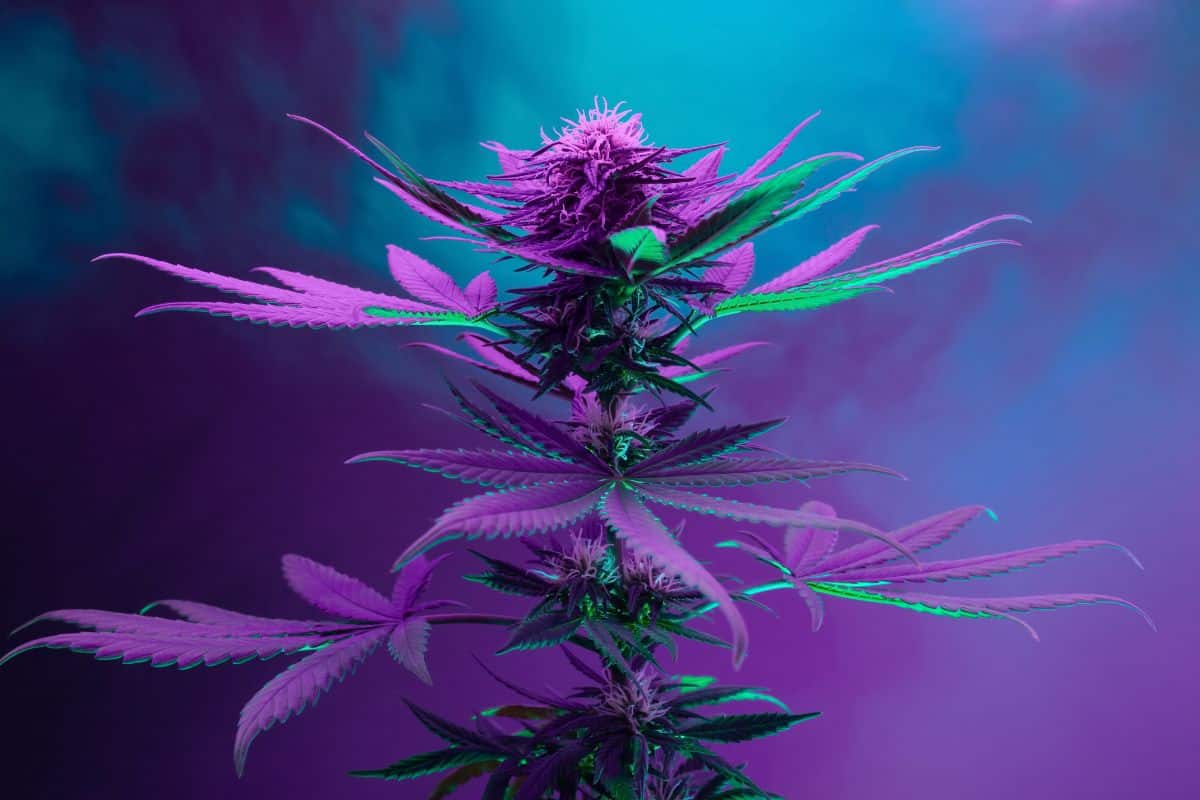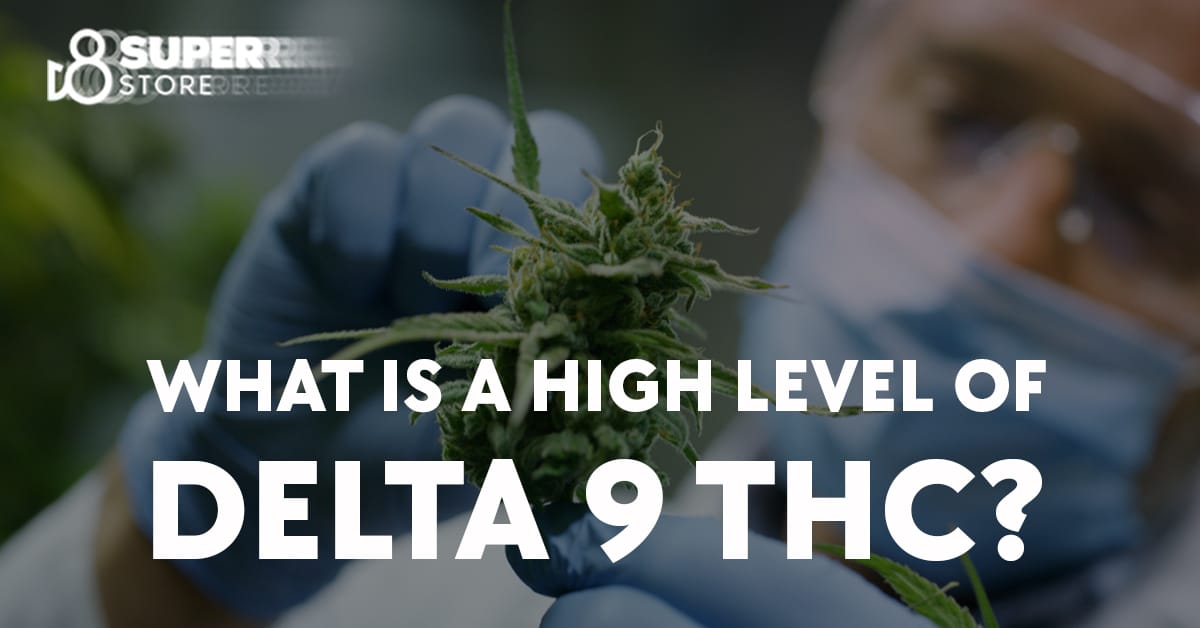What is a High Level of Delta-9 THC: Understanding the Potency Threshold
The primary psychoactive compound found in cannabis plants is delta-9-tetrahydrocannabinol (THC), which is responsible for the well-known “high” experienced by marijuana users. Over the years, the THC levels in cannabis have been steadily increasing, causing concerns about the potency of marijuana products and their potential effects on users. Therefore, it is essential for both consumers and regulators to understand what constitutes a high level of delta-9 THC in order to protect public health. To learn more about the differences between indica, sativa, and hybrid cannabis strains, visit d8superstore.com/indica-vs-sativa-vs-hybrid. For information specifically on delta-9 THC, visit d8superstore.com/category/delta-9.
The concentration of THC in cannabis typically ranges from a low of 0.3% in industrial hemp to as much as 30% or more in certain strains of marijuana. As the THC content in marijuana increases, so does the potency of the product, resulting in stronger psychoactive effects. High levels of delta-9 THC can lead to increased euphoria, but may also cause undesirable side effects such as anxiety, paranoia, and impaired cognitive function.
To determine what constitutes a high level of delta-9 THC, it’s essential to consider factors such as individual tolerance, consumption method, and the specific strain of cannabis being used. New users may be more sensitive to THC’s effects, while more experienced users may have a higher tolerance to the compound. Ultimately, a high level of delta-9 THC depends on the specific individual and the context in which it is consumed.
Understanding Delta-9 THC
Delta-9-tetrahydrocannabinol, often abbreviated as Delta-9 THC, is one of the primary psychoactive compounds found in the cannabis plant. This cannabinoid is known for inducing the characteristic “high” associated with marijuana use. Delta-9 THC interacts with the endocannabinoid system in the body, which plays a vital role in regulating numerous physiological processes, including mood, memory, and appetite.
There is a range of Delta-9 THC concentrations in different strains of cannabis, which can influence the intensity and duration of the psychoactive effects. The potency of cannabis is generally measured by the percentage of Delta-9 THC by weight. A high level of Delta-9 THC is considered to be anything above 20%. In recent years, advanced cultivation and breeding techniques have led to the development of strains with even higher THC levels, sometimes exceeding 30%.
The effects of Delta-9 THC can vary significantly among individuals, depending on factors such as tolerance, body chemistry, and the method of consumption. Smoking or vaping cannabis can lead to faster delivery and higher levels of Delta-9 THC in the bloodstream, compared to other methods like consuming edibles. Consequently, the onset, intensity, and duration of the psychoactive effects may differ significantly.
Research on Delta-9 THC has revealed several potential therapeutic benefits, such as pain relief, nausea reduction, and appetite stimulation. However, high levels of Delta-9 THC can also cause side effects, including anxiety, paranoia, and cognitive impairments. It is essential for individuals using cannabis for medical or recreational purposes to understand how Delta-9 THC levels influence the experience and potential risks involved.
In summary, Delta-9 THC is a key component in cannabis responsible for producing psychoactive effects. The concentration of this cannabinoid varies among strains and can influence the intensity of the experience. Understanding the role of Delta-9 THC, its potential benefits, and associated risks can help individuals make informed decisions about their cannabis usage.
The Effects of High Levels of THC

Delta-9-tetrahydrocannabinol (THC) is the primary psychoactive compound in cannabis. Consuming higher levels of THC can lead to various effects on the brain and body, some of which may be undesirable. It is essential to understand the possible outcomes before engaging in cannabis consumption.
High levels of THC typically induce a more potent psychoactive experience. Users may report feeling a stronger sense of relaxation, euphoria, and increased sensory perception. However, these heightened sensations can also lead to negative outcomes, especially in individuals who are inexperienced or sensitive to THC.
One of the primary concerns at higher THC concentrations is the increased likelihood of paranoia. In some cases, elevated THC levels can cause users to feel extreme anxiety or fear, resulting in a sense of panic and unease. This may be especially distressing for those predisposed to anxiety disorders or have a history of panic attacks.
Moreover, cognitive function may be impaired at higher THC levels, potentially affecting short-term memory, attention, and decision-making skills. These cognitive impairments can make everyday tasks and responsibilities more challenging to manage, posing a higher risk of accidents or poor judgment.
Additionally, when exposed to high THC levels, the cardiovascular system may be affected. THC can increase heart rate, potentially leading to increased blood pressure and cardiac stress. This can be particularly dangerous for those with pre-existing cardiovascular conditions or who are at risk for heart disease.
Lastly, consuming high amounts of THC may also have an impact on sleep patterns. Research has shown that high doses of THC could disrupt the normal stages of sleep, potentially altering the quality and restorative properties of sleep. This could lead to increased fatigue and daytime sleepiness.
In conclusion, the effects of high levels of THC can vary from person to person and depend on the individual’s tolerance and sensitivity. While some may experience positive feelings of relaxation and euphoria, others may encounter negative outcomes such as paranoia, impaired cognitive function and altered sleep patterns. Taking this into account, it is crucial for users to be aware of the potential risks and decide responsibly when consuming cannabis with high THC concentrations.
Medical and Recreational Uses of THC
| Use | Medical Benefits | Recreational Use |
|---|---|---|
| Pain Management | – Effective pain relief for chronic pain conditions | – Enhanced sense of relaxation and euphoria |
| – Useful for neuropathic pain, arthritis, and more | – Potential “high” or altered perception | |
| Nausea and Vomiting | Can alleviate nausea and vomiting, often used in cancer chemotherapy | May enhance enjoyment of food and reduce nausea when not medically needed |
| Appetite Stimulation | Helps stimulate appetite, useful for patients with appetite loss or eating disorders | Commonly known as “getting the munchies,” THC can increase hunger |
| Muscle Spasms | Reduces muscle spasms and spasticity, especially in conditions like multiple sclerosis (MS) | Muscle relaxation and relief from tension |
| Glaucoma | Lowers intraocular pressure in some cases, potentially benefiting individuals with glaucoma | May temporarily relieve eye pressure, although not recommended as a primary treatment |
| Anxiety and Stress | Can provide short-term relief from anxiety and stress, although long-term use may exacerbate anxiety | Often used recreationally for relaxation and stress relief |
| Insomnia | May help with sleep by inducing relaxation and reducing the time it takes to fall asleep | Often used recreationally for its sedative effects |
| Cancer | Some research suggests that THC may have anticancer properties, although more studies are needed | Recreational use may not have a direct link to cancer treatment |
| Creativity | Some users report enhanced creativity and altered thinking under the influence of THC | Enjoyed for its ability to stimulate creative thinking and novel ideas |
| Enhanced Sensory Perception | Heightened sensory perception, such as intensified colors and sounds, can be experienced | Appreciated by some for its ability to make music, art, or nature more enjoyable |
| Social and Recreational Activities | THC can enhance social interactions and leisure activities, making them more enjoyable | Commonly used in social settings for relaxation, fun, and bonding |
| Mood Elevation | Can induce feelings of euphoria and happiness | Often sought for its ability to improve mood and create a sense of well-being |
Delta-9-tetrahydrocannabinol (THC) is the primary psychoactive compound found in marijuana plants. It is responsible for most of the plant’s psychological effects and has a range of medical and recreational uses. This cannabinoid interacts with the endocannabinoid system in the human body, producing various effects that can help manage several health issues.
One of the well-known medical benefits of THC is its ability to alleviate pain. Numerous studies have shown that this compound can provide relief for patients suffering from chronic pain, as well as for those experiencing pain due to conditions like multiple sclerosis and arthritis. Patients with neuropathic pain might also benefit from THC use, as it can help to reduce the intensity of the discomfort.
Another significant use of THC in the medical field is to treat nausea and vomiting, especially in patients undergoing chemotherapy. Cancer treatments often cause severe nausea, leading to a reduced appetite and weight loss. THC has been found to effectively alleviate these symptoms, allowing patients to maintain their appetite and prevent malnutrition.
Speaking of appetite, THC also has a crucial role in improving low appetite, primarily among patients with HIV/AIDS. The compound triggers the release of hormones that encourage hunger, helping to counteract the appetite loss caused by illness and medication.
Furthermore, THC has shown potential in aiding individuals suffering from insomnia. A moderate to high dose of THC can induce drowsiness and promote relaxation, assisting people in falling asleep and staying asleep throughout the night.
Despite the various medical benefits, THC is also commonly used for recreational purposes. When consumed, it gives users a sense of euphoria or “high,” which contributes to the majority of its appeal in the recreational market. States and countries that have legalized marijuana for recreational use have opened new avenues for people to enjoy the relaxing and mood-enhancing effects of THC in a regulated and safe environment.
In conclusion, whether used for medical or recreational purposes, delta-9-THC remains an important compound with numerous beneficial effects on the human body. Its role in pain relief, appetite stimulation, anti-nausea, and sleep inducement highlights the significance of its potential in the medical field; while its recreational use caters to the evolving demands for a more diverse range of user experiences.
The Cannabis Plant and THC

The cannabis plant, also known as marijuana or hemp, contains numerous chemical compounds, one of which is delta-9-tetrahydrocannabinol (Δ-9 THC). This specific compound is responsible for the psychoactive effects associated with cannabis use, leading to the “high” sensation experienced by users. While there are many strains and varieties of cannabis plants, each with different levels of THC, understanding what constitutes a high level of THC is essential.
Cannabis plants can be broadly categorized into two types: Cannabis sativa and Cannabis indica. These plants differ in their size, appearance, growth patterns, and the concentration of THC and other compounds. In general, Cannabis sativa plants have a higher THC content, while Cannabis indica plants contain more cannabidiol (CBD), a non-psychoactive component known for its potential therapeutic effects.
Hemp, which refers to non-intoxicating strains of the Cannabis sativa plant, is cultivated for various industrial purposes, such as for making fibers, paper, and food products. Legally, hemp is defined as having a THC content of less than 0.3%. This minimal level of THC ensures that it does not produce psychoactive effects.
Marijuana, on the other hand, is specifically cultivated for its THC content. Over time, the delta-9 THC concentration in herbal cannabis has steadily increased due to selective breeding and other cultivation techniques. The definition of a high level of THC depends on various factors, including the user’s tolerance and the potency of other cannabinoids present in the plant. However, marijuana strains with a THC content of over 20% are generally considered to be high in potency.
In summary, the cannabis plant, comprising both marijuana and hemp, contains numerous chemical compounds, with THC being the primary psychoactive constituent. A high level of THC is typically associated with marijuana strains containing over 20% THC content. For industrial hemp, the legal THC limit is below 0.3%, ensuring its non-intoxicating nature.
Legalities Surrounding THC
| THC Legal Status | Description |
|---|---|
| 1. Federal Level | THC remains illegal at the federal level in the United States. It is classified as a Schedule I controlled substance under the Controlled Substances Act, alongside drugs like heroin and LSD. This means that the federal government considers it to have a high potential for abuse and no accepted medical use. |
| 2. Medical Use | Some states have legalized the medical use of THC or products containing THC. Patients with qualifying medical conditions can obtain medical marijuana cards and purchase THC products from licensed dispensaries. The specific regulations vary by state, including the forms of THC allowed and the conditions for which it can be prescribed. |
| 3. Recreational Use | Several states have legalized the recreational use of THC for adults (21 and older). Individuals in these states can purchase and possess limited amounts of THC for personal use. Again, the regulations, including possession limits and licensing requirements for retailers, vary by state. |
| 4. Hemp-Derived CBD | Hemp-derived CBD products with less than 0.3% THC are legal at the federal level. These products are available for purchase and use without a prescription in most states, though some states have additional restrictions. |
| 5. Delta-8 THC | Delta-8 THC, a variant of THC, exists in a legal gray area. Some states have explicitly banned it, while others allow it with varying degrees of regulation. Its legality may change over time as state and federal authorities review its status. |
| 6. Transport Across State Lines | Transporting THC products across state lines can be illegal, even when traveling between states where it’s legal. Federal regulations often supersede state laws, and interstate transportation of THC can result in legal consequences. |
| 7. Workplace and Drug Testing | Many employers maintain drug-free workplace policies, and THC use, even in states where it’s legal, can result in workplace consequences, including termination. |
| 8. Legal Changes | THC laws are subject to change, both at the state and federal levels. States may revise their laws, and there is ongoing debate at the federal level regarding potential changes to THC’s legal status. It’s important to stay informed about the laws in your specific state. |
In the United States, the legal status of delta-9-tetrahydrocannabinol (THC), the primary psychoactive compound in cannabis, varies between state and federal jurisdictions. At the federal level, THC remains classified as a Schedule I substance under the Controlled Substances Act, meaning that it is considered to have a high potential for abuse and no accepted medical use. The possession, distribution, and cultivation of THC-containing products are therefore illegal under federal law.
However, many states have adopted their own policies regarding THC, with some, such as California and Colorado, permitting recreational use, while others limit access to medical patients. These state-level legalizations have created a complex regulatory landscape, as individuals may be permitted to use THC in accordance with their state’s laws, but still risk potential federal prosecution. Furthermore, states that have legalized THC for medical or recreational purposes have instituted diverse frameworks for regulating its production, distribution, and consumption.
As a result of this patchwork of state laws, the concentration of THC in cannabis products can differ significantly between jurisdictions. In states where recreational use is legal, it is not uncommon to find products with high THC levels, up to 20% or more, readily available for sale. In contrast, states with stricter regulations, such as those that only allow low-THC medical cannabis, may impose limitations on the maximum allowable THC concentration.
One relevant example of state-level legislation comes from Florida, which has legalized medical cannabis and defined low-THC products as those containing no more than 0.8% THC. Such restrictions are intended to promote the therapeutic benefits of cannabis without exposing patients to the psychoactive effects associated with higher concentrations of THC. However, this approach has also raised concerns among consumers and regulators alike regarding the adulteration of low-THC products with synthetic cannabinoids, which may pose additional health risks.
In summary, the legal landscape surrounding THC in the United States is marked by considerable variation between state and federal jurisdictions. While some states have embraced more permissive policies, allowing products with high THC concentrations for recreational or medical use, others maintain strict regulations to limit the availability and potency of THC-containing products. As the legal status of THC continues to evolve, it remains important for consumers, healthcare providers, and policymakers alike to stay abreast of developments in their jurisdictions, and to weigh the potential risks and benefits of differing approaches to cannabis regulation.
THC and Its Comparison With Other Cannabinoids

| Cannabinoid | THC (Tetrahydrocannabinol) | CBD (Cannabidiol) | CBG (Cannabigerol) | CBN (Cannabinol) | CBC (Cannabichromene) |
|---|---|---|---|---|---|
| Chemical Structure | Psychoactive compound responsible for the “high” in cannabis | Non-psychoactive cannabinoid | Non-psychoactive precursor to other cannabinoids | Mildly psychoactive with sedative effects | Non-psychoactive cannabinoid |
| Common Sources | Abundant in cannabis strains, particularly marijuana | Found in both marijuana and hemp strains | Typically present in low concentrations | Forms as THC breaks down over time | Present in various cannabis strains |
| Psychoactive Effect | Strong psychoactive effects, including euphoria, altered perception, and potential anxiety/paranoia | Non-psychoactive, does not produce a “high” | Non-psychoactive, but may have mild effects on mood and appetite | Mildly psychoactive with sedative effects, may induce drowsiness | Non-psychoactive, does not produce a “high” |
| Medical Benefits | Effective pain relief, anti-nausea, muscle relaxant, appetite stimulant | Various potential medical uses, including pain relief, anxiety reduction, and seizure control | May have antibacterial and anti-inflammatory properties, potential in glaucoma treatment | Mild sedative effects, potential for sleep aid, anti-convulsant | Potential anti-inflammatory, anti-fungal, and pain-relieving properties |
| Side Effects | Potential for anxiety, paranoia, dry mouth, and increased heart rate | Generally well-tolerated, but can cause drowsiness, dry mouth, and changes in appetite | Few reported side effects, well-tolerated in limited studies | Drowsiness, dry mouth, and potential for grogginess | Rarely reported side effects, generally considered safe |
| Legal Status | Federally illegal in the United States, legal for medical and/or recreational use in some states | Legal in some form in many states, federally legal if derived from hemp with less than 0.3% THC | Legal in some states, regulations vary | Legal in some states, often regulated like THC | Legal in some states, regulations vary |
| Entourage Effect | A key component of the entourage effect, where the combination of cannabinoids and terpenes enhances therapeutic effects | Contributes to the entourage effect, enhancing the effects of other cannabinoids | May contribute to the entourage effect by interacting with other cannabinoids | May enhance the entourage effect, especially when combined with THC | Plays a role in the entourage effect, enhancing the effects of other cannabinoids |
| Research Status | Extensively studied, both for its benefits and potential risks | Well-studied for its various therapeutic properties | Research ongoing, with potential applications in various medical conditions | Limited research, primarily related to its potential as a sleep aid | Growing interest, but research is still in early stages |
Delta-9-tetrahydrocannabinol (THC) is the primary psychoactive compound found in cannabis plants. THC is responsible for the intoxicating effects or “high” associated with marijuana use. However, it’s not the only cannabinoid present in cannabis; there are over 100 different cannabinoids, such as cannabigerol (CBG), cannabinol (CBN), and cannabidiol (CBD). Each of these has distinct properties and functions within the body’s endocannabinoid system.
- Cannabidiol (CBD) is the second most abundant cannabinoid in cannabis plants and has gained popularity for its therapeutic potential. Unlike THC, CBD does not cause intoxicating effects, making it an attractive option for those seeking the benefits of cannabis without the psychoactive side effects. Some of the potential benefits of CBD use include pain relief, anxiety reduction, and anti-inflammatory properties. CBD is often used in conjunction with THC in medical applications, as their combined effects can enhance the therapeutic benefits while reducing unwanted side effects of THC, such as anxiety and paranoia.
- Cannabigerol (CBG) is another non-psychoactive cannabinoid found in cannabis plants, although in much lower concentrations than THC or CBD. CBG has shown promise for various medical applications due to its potential anti-inflammatory, antimicrobial, and analgesic properties. Although not as well-known as THC or CBD, CBG is rapidly gaining attention from researchers and consumers alike for its potential therapeutic benefits.
- Cannabinol (CBN) is a mildly psychoactive cannabinoid found in trace amounts within the cannabis plant. CBN is primarily formed by the degradation of THC when the plant is exposed to heat or light. Like CBD and CBG, CBN has demonstrated potential therapeutic benefits such as anti-inflammatory and analgesic effects. Additionally, CBN has been reported to have sedative properties, making it a potential sleep aid for some individuals.
In conclusion, while THC is the most well-known cannabinoid in cannabis plants, other cannabinoids like CBD, CBG, and CBN also exhibit significant potential for therapeutic applications. Each of these cannabinoids has unique properties and interaction within the endocannabinoid system, making them valuable additions to the rapidly expanding field of cannabis research and medicine.
Testing and Interpretation of THC Levels
Delta-9-tetrahydrocannabinol (THC) is the primary psychoactive compound found in marijuana. Testing and interpretation of THC levels are important to determine the concentration of the substance in a person’s system. Different types of tests can be employed to measure the presence of THC, including drug tests involving urine, blood, and oral fluid samples.
Urine tests are the most common method used for detecting the presence of THC in the body. These tests measure the metabolite of THC, called THC-COOH, which can be detected in urine for an extended period, depending on individual factors like frequency of use and body fat percentage. The typical cutoff value for a positive urine test is 50 nanograms per milliliter (ng/mL). However, some tests may have a lower threshold, while others may require a higher concentration for a positive result.
Blood tests can also be used to determine THC levels, although they are less common due to the invasive nature of the procedure and the shorter detection window. According to a study, THC concentrations in blood can be lower than in other cannabis products, making it more difficult to accurately determine the THC levels. A positive result in a blood test may indicate recent use, as THC levels in blood usually peak within minutes of consumption and then decline rapidly over the next few hours.
Oral fluid tests are another method for detecting THC in the body, though not as common as urine and blood tests. These tests analyze saliva samples for the presence of THC. Since THC typically shows up in saliva within minutes of consumption and can be detected for up to 24 hours after use, oral fluid tests can be useful for detecting recent marijuana consumption.
It is essential to interpret THC levels accurately to differentiate between a high level of THC and trace amounts. High levels of THC are generally associated with a greater likelihood of impairment, although individual tolerance and metabolism can play a role in how one experiences the effects. A combination of test results, clinical observations, and self-reported use can provide a clearer understanding of the overall THC levels in a person’s system.
In summary, testing and interpreting THC levels can be done through various methods, including urine, blood, and oral fluid tests. Identifying high THC levels can provide valuable information regarding potential impairment and recent consumption of marijuana. As the effects and detection windows can vary among individuals, an accurate interpretation of test results helps to better understand a person’s THC exposure.
Alcohol Vs THC

Alcohol and THC (delta-9-tetrahydrocannabinol) are two commonly used recreational substances with varying effects on human behavior, cognition, and motor skills. Both substances are known to cause impairments, albeit through different mechanisms and to varying degrees.
Alcohol is a central nervous system depressant that affects multiple neurotransmitter systems. Its consumption leads to a range of cognitive and motor impairments including but not limited to sedation, slower reaction times, and decreased coordination. The impairments induced by alcohol exposure are dose-dependent, and higher levels of consumption are associated with more significant impairments.
On the other hand, THC is the primary psychoactive compound found in cannabis, responsible for the “high” users experience. It acts by binding to cannabinoid receptors in the brain, particularly in areas associated with memory, pleasure, and concentration. THC exposure can result in alterations in mood, perception, and cognition. Additionally, THC can impair motor functions, such as reaction time and coordination, similar to the effects of alcohol. However, the extent of impairment depends on factors such as the dose, potency, and delivery method of THC.
Studies have investigated the combined effects of alcohol and THC on human behavior and cognition. Their results suggest that consuming even very low doses of both substances together can lead to synergistic effects, with subjects experiencing more significant impairment than consuming either substance alone.
In conclusion, both alcohol and THC are capable of causing impairments in cognitive and motor functions, although their effects may vary depending on factors such as dosage and individual sensitivity. When used in combination, the impairments from alcohol and THC can be more pronounced, indicating that caution should be exercised when consuming these substances simultaneously.
Frequently Asked Questions
What are the side effects of high Delta-9 THC levels?
High levels of Delta-9 THC can cause various side effects, including increased heart rate, dry mouth, red eyes, dizziness, and impaired memory. Another common side effect is a higher degree of sedation compared to lower doses of THC. These side effects may vary among individuals, but the intensity and duration usually depend on the dose and individual’s tolerance.
How do Delta-9 THC and Delta-8 THC highs compare?
Delta-9 THC and Delta-8 THC are both cannabinoids found in cannabis, but they produce different effects. Delta-9 THC typically induces a more potent psychoactive high, whereas Delta-8 THC tends to have milder effects. Some users describe Delta-8 THC as a “functional high,” with less anxiety and a more clear-headed experience compared to Delta-9 THC.
What are the legal implications of high Delta-9 THC?
The legal implications of Delta-9 THC depend on your jurisdiction, as laws around cannabis and its components vary widely across different countries and states. In some regions, possession, use, or sale of high-THC cannabis products may be subject to strict regulations or criminal penalties. It is essential to be familiar with your local laws and regulations regarding Delta-9 THC usage and possession.
What are the effects of high Delta-9 THC levels on the body?
High levels of Delta-9 THC can have various effects on the body, including altered perception, reduced anxiety, and changes in the evaluation of emotional images. These effects can also lead to increased appetite, euphoria, and relaxation. It may also have a significant impact on the central nervous system, affecting motor coordination, reaction time, cognitive functions, and mood.
How much Delta-9 THC is considered a safe dosage?
The safe dosage of Delta-9 THC mainly depends on an individual’s tolerance, body weight, and previous experience with the substance. For new users, a lower dose—such as 2.5 mg to 5 mg—may be more appropriate, while experienced users may feel comfortable with higher doses. However, it is essential to consult a healthcare professional or a licensed cannabis dispensary for personalized recommendations.
Is it possible to overdose on Delta-9 THC?
While a fatal overdose on Delta-9 THC is unlikely, it is possible to experience uncomfortable side effects and temporary symptoms of an overdose. These may include extreme paranoia, anxiety, hallucinations, nausea, and rapid heart rate. In such cases, it is essential to remain calm, hydrated, and rest in a safe environment until the symptoms subside. If symptoms worsen or persist, seeking medical attention may be necessary.







